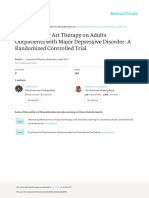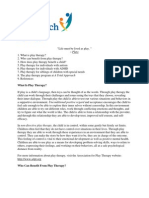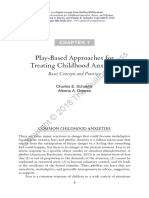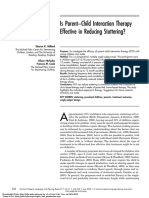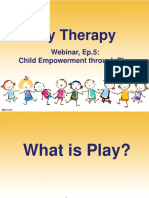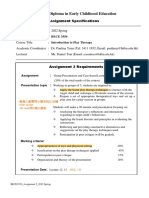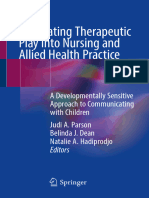Play Therapy 1
Play Therapy 1
Uploaded by
api-496155980Copyright:
Available Formats
Play Therapy 1
Play Therapy 1
Uploaded by
api-496155980Original Title
Copyright
Available Formats
Share this document
Did you find this document useful?
Is this content inappropriate?
Copyright:
Available Formats
Play Therapy 1
Play Therapy 1
Uploaded by
api-496155980Copyright:
Available Formats
Play Therapy
AN EXPLANATION AND HOW IT IS BENEFICIAL
WHAT IS PLAY THERAPY?
The Association for Play Therapy (APT) defined play
therapy as "the systematic use of a theoretical
model to establish an interpersonal process
wherein trained play therapists use the therapeutic
powers of play to help clients prevent or resolve
psychosocial difficulties and achieve optimal
grwoth and development".
WHAT MAKES PLAY
THERAPY DIFFERENT FROM
REGULAR PLAY?
Play therapy differs from regular play in that the
therapist helps children to address and resolve their
own problems. It helps build on the natural way
that children learn about themselves and the
realtionships in the world around them.
WHAT ARE THE BENEFITS TO PLAY THERAPY?
Can help children:
Become more responsible for behaviors and develop more successful
strategies
Develop new and creative solutions to problems
Develop respect and acceptance of self and others
Learn to experience and express emotion
Cultivate empathy and respect for thoughts and feelings of others
Learn new social skills and relational skills with family
Develop self-efficacy and thus a better assuredness about their abilities
ARE CHILDREN THE ONLY
DEMOGRAPHIC WHO CAN
BENEFIT FROM PLAY THERAPY?
No, but clients usually seen in play therapy are children
ranging from ages 3-12 years old. Teenagers and
Adults have also benefited from play techniques and
recreational processes.
WHY CHOOSE PLAY
THERAPY?
In play therapy, toys are like the child's words and
play is the child's language. Through play,
therapists may help children learn more adaptive
behaviors when there are emotional or social skills
deficit.
1. Association for Play Therapy. (n.d.). Play Therapy Makes a Difference. Retrieved from
https://www.a4pt.org/page/PTMakes a difference/Play-Therapy-Makes-a-Difference.htm
2. Carmichael, K. D. (2006). Play therapy: An introduction. Glenview, IL: Prentice Hall.
COMPILED BY
a. Landreth, G. L. (2002). Play therapy: The art of the relationship. New York, NY: Brunner-Ruttledge.
3. Carmichael, K. D. (2006). Play therapy: An introduction. Glenview, IL: Prentice Hall.
a. Gil, E. (1991). Healing power of play: Working with abused children. New York, NY: The Guilford Press.
ABIGAIL b. Landreth, G. L. (2002). Play therapy: The art of the relationship. New York, NY: Brunner-Ruttledge.
c. Schaefer, C. E. (1993). The therapeutic power of play. Northvale, NJ: Jason Aronson, Inc.
FLORIANO 4. Pedro-Carroll, J., & Reddy, L. (2005). A preventive play intervention to foster children's resilience in the aftermath of
divorce. In L. Reddy, T. Files-Hall, & C. Schaefer (Eds.), Empirically based play interventions for children (pp.51-75).
SOURCE/S: Washington, DC: American Psychological Association.
a. Schaefer, C. E. (2003). Play therapy with adults. Hoboken, NJ: John Wiley & Sons.
5. Landreth, G. L. (2002). Play therapy: The art of the relationship. New York, NY: Brunner-Ruttledge.
6. Pedro-Carroll, J., & Reddy, L. (2005). A preventive play intervention to foster children's resilience in the aftermath of
divorce. In L. Reddy, T. Files-Hall, & C. Schaefer (Eds.), Empirically based play interventions for children (pp.51-75).
Washington, DC: American Psychological Association.
You might also like
- When Clients Can't Connect or Name Their EmotionsDocument28 pagesWhen Clients Can't Connect or Name Their EmotionsMaria NascimentoNo ratings yet
- Play TherapyDocument487 pagesPlay TherapyAndris DominicciNo ratings yet
- The SPACE Program, A Parent-Based Treatment For Childhood and Adolescent AnxietyDocument12 pagesThe SPACE Program, A Parent-Based Treatment For Childhood and Adolescent Anxietyilda.jackmakianNo ratings yet
- Gestalt Play Terapy PDFDocument248 pagesGestalt Play Terapy PDFNagy Pepe100% (3)
- Nan & Ho 2017 - Effects of Clay Art Therapy On Adults Outpatients With MDDDocument10 pagesNan & Ho 2017 - Effects of Clay Art Therapy On Adults Outpatients With MDDMatthew Mak100% (2)
- Ictc-C Treatment ManualDocument124 pagesIctc-C Treatment Manualapi-279694446No ratings yet
- Play Therapy (Report Outline)Document4 pagesPlay Therapy (Report Outline)Jan Michael Suarez100% (1)
- Helping Children Cope With GriefDocument2 pagesHelping Children Cope With GriefvijayNo ratings yet
- 3 5 Axlines Case Study of Dibs 1964Document2 pages3 5 Axlines Case Study of Dibs 1964temi100% (1)
- Play Therapy With Adults by Schaefer SmartDOCDocument6 pagesPlay Therapy With Adults by Schaefer SmartDOCCatalina Serban0% (2)
- Brief Family-Based Crisis Intervention (Cftsi) - Stephen BerkowitzDocument20 pagesBrief Family-Based Crisis Intervention (Cftsi) - Stephen Berkowitzapi-279694446No ratings yet
- Mini Screen: P N: - D B: - D IDocument2 pagesMini Screen: P N: - D B: - D IDaniel DascaluNo ratings yet
- TheraplayDocument11 pagesTheraplayRoxi ResurreccionNo ratings yet
- Schema Therapy Children PDFDocument38 pagesSchema Therapy Children PDFmina mirNo ratings yet
- Play TherapyDocument19 pagesPlay TherapyKing GilgameshNo ratings yet
- Fifteen Effective Play Therapy TechniquesDocument8 pagesFifteen Effective Play Therapy TechniquesDiana GioganNo ratings yet
- Play Janeece Warfield, Psy.D., RPT-SDocument19 pagesPlay Janeece Warfield, Psy.D., RPT-SNadeem Iqbal100% (1)
- Play Therapy 2Document3 pagesPlay Therapy 2Pradeep KumarNo ratings yet
- Fifteen Effective Play Therapy TechniquesDocument9 pagesFifteen Effective Play Therapy Techniquesneculai.daniela78771No ratings yet
- Introduction To Play TherapyDocument10 pagesIntroduction To Play TherapyJan Michael Suarez100% (1)
- Child Play TherapyDocument3 pagesChild Play TherapyfarahzNo ratings yet
- The Use of Play For Assessment and Therapy The Case of A Child With Selective MutismDocument13 pagesThe Use of Play For Assessment and Therapy The Case of A Child With Selective MutismdiniNo ratings yet
- © 2018 The Guilford Press: Play-Based Approaches For Treating Childhood AnxietiesDocument10 pages© 2018 The Guilford Press: Play-Based Approaches For Treating Childhood Anxietiesneculai.daniela78771No ratings yet
- Art TherapyDocument13 pagesArt Therapyapi-2776195270% (1)
- Is Parent-Child Interaction Therapy Effective in Reducing StutteringDocument15 pagesIs Parent-Child Interaction Therapy Effective in Reducing StutteringMagaliNo ratings yet
- School-Based Interventions For Children Who Have Experienced Trauma - NASP 2010Document72 pagesSchool-Based Interventions For Children Who Have Experienced Trauma - NASP 2010danniey66No ratings yet
- Intensive Child Centered Play Therapy Fo-1Document11 pagesIntensive Child Centered Play Therapy Fo-1Kainat MunirNo ratings yet
- History and Development of Play TherapyDocument1 pageHistory and Development of Play TherapyLingNo ratings yet
- Non Directive Play TherapyDocument1 pageNon Directive Play Therapyjv10gmail0% (1)
- Interventions For Children With RADDocument6 pagesInterventions For Children With RADJohn Bitsas100% (2)
- Play Therapy in Dealing With Bereavement and Grief in Autistic Child: A Case Study by PrabhaDocument3 pagesPlay Therapy in Dealing With Bereavement and Grief in Autistic Child: A Case Study by PrabhaSeshan RanganathanNo ratings yet
- Guide Questions-Creative Art TherapiesDocument5 pagesGuide Questions-Creative Art TherapiesRamil NumioNo ratings yet
- Adlerian Play TherapyDocument34 pagesAdlerian Play TherapySania JawedNo ratings yet
- Eliana Gil The Healing Power of Play Working With Abused Children The Guilford Press 1991Document225 pagesEliana Gil The Healing Power of Play Working With Abused Children The Guilford Press 1991cristina.balasa777No ratings yet
- Module 1 Young Children and Trauma PowerPointDocument51 pagesModule 1 Young Children and Trauma PowerPointArthur100% (1)
- Play TherapyDocument2 pagesPlay TherapyravensuichiroNo ratings yet
- Liana Lowenstein Article PDFDocument6 pagesLiana Lowenstein Article PDFArens SimonaNo ratings yet
- Child-Centered Play TherapyDocument17 pagesChild-Centered Play TherapySholihatul Amaliya100% (1)
- Piperno, F., Biasi, S. & Levi, G. (2007) - Evaluation of Family Drawings of Physically and Sexually Abused ChildrenDocument10 pagesPiperno, F., Biasi, S. & Levi, G. (2007) - Evaluation of Family Drawings of Physically and Sexually Abused ChildrenRicardo NarváezNo ratings yet
- Family Systems Theory Is Derived From General Systems TheoryDocument3 pagesFamily Systems Theory Is Derived From General Systems TheoryMonnica WellerubunNo ratings yet
- Relating Developmental StagesDocument4 pagesRelating Developmental StagesAngelica Traxnoma100% (1)
- Play Therapy Webinar 5Document33 pagesPlay Therapy Webinar 5disha chhedaNo ratings yet
- Speech-Language Dissociations, Distractibility, and Childhood StutteringDocument24 pagesSpeech-Language Dissociations, Distractibility, and Childhood Stutteringyeremias setyawanNo ratings yet
- Case Formulation TemplateDocument2 pagesCase Formulation Templateraysun1No ratings yet
- Grief and Loss of A CaregiverDocument6 pagesGrief and Loss of A CaregiverGanda KurniawanNo ratings yet
- Art TherapyDocument23 pagesArt TherapyMarcosNo ratings yet
- Attachment PresentationDocument4 pagesAttachment Presentationapi-290018716No ratings yet
- Play TherapyDocument6 pagesPlay Therapy妙慈No ratings yet
- Theories of Counseling: Multicultural CounselingDocument24 pagesTheories of Counseling: Multicultural Counselingdaffdg dsfNo ratings yet
- Applying An Integrated Approach To A CasDocument4 pagesApplying An Integrated Approach To A CasMacxieNo ratings yet
- Cognitive Therapy in The Treatment of Low Self-Esteem: References ReprintsDocument10 pagesCognitive Therapy in The Treatment of Low Self-Esteem: References ReprintsSulaksono Dwi AriNo ratings yet
- Transference Focused Psychotherapy (TFP) Foundational Training: Narcissistic Personality Disorder (NPD)Document3 pagesTransference Focused Psychotherapy (TFP) Foundational Training: Narcissistic Personality Disorder (NPD)kingawitkNo ratings yet
- Play Therapy FinalDocument8 pagesPlay Therapy FinalChandru KowsalyaNo ratings yet
- Family System TheoryDocument23 pagesFamily System TheoryZaiden John RoquioNo ratings yet
- استمارة المشاهدة والنقدDocument2 pagesاستمارة المشاهدة والنقدDr.Doaa Mohamed SayedNo ratings yet
- Group Therapy and Family TherapyDocument26 pagesGroup Therapy and Family TherapyDhAiRyA ArOrA100% (1)
- Instant Ebooks Textbook Mentalization Based Treatment For Adolescents A Practical Treatment Guide 1st Edition Trudie Rossouw Download All ChaptersDocument84 pagesInstant Ebooks Textbook Mentalization Based Treatment For Adolescents A Practical Treatment Guide 1st Edition Trudie Rossouw Download All Chaptersyellebonfin100% (3)
- 1 - Clinical - History - 29Document29 pages1 - Clinical - History - 29TitakawaiiNo ratings yet
- Panic AttacksDocument21 pagesPanic Attacksp1a2n3i4c54715100% (1)
- Art Therapy For Abused Children PDFDocument86 pagesArt Therapy For Abused Children PDFelam23No ratings yet
- Children and GriefDocument3 pagesChildren and GriefRommel Villaroman EstevesNo ratings yet
- Advocating For Play TherapyDocument12 pagesAdvocating For Play TherapyRoxi ResurreccionNo ratings yet
- Collaborative Problem Solving: An Evidence-Based Approach to Implementation and PracticeFrom EverandCollaborative Problem Solving: An Evidence-Based Approach to Implementation and PracticeAlisha R. PollastriNo ratings yet
- Reflection Paper 4Document3 pagesReflection Paper 4api-496155980No ratings yet
- Reflection Paper 2Document4 pagesReflection Paper 2api-496155980No ratings yet
- Reflection Paper 3Document4 pagesReflection Paper 3api-496155980No ratings yet
- 12 Step Meeting Paper Abigail Floriano AutorecoveredDocument4 pages12 Step Meeting Paper Abigail Floriano Autorecoveredapi-496155980No ratings yet
- Virtual Life Reflection Paper 2Document7 pagesVirtual Life Reflection Paper 2api-496155980No ratings yet
- Paper Draft AbnormalDocument9 pagesPaper Draft Abnormalapi-496155980No ratings yet
- Small Paper For Social PsychDocument5 pagesSmall Paper For Social Psychapi-496155980No ratings yet
- My Virtual Life Reflection PaperDocument6 pagesMy Virtual Life Reflection Paperapi-496155980No ratings yet
- Sas Psych Answers2Document29 pagesSas Psych Answers2mathewdumayac100% (1)
- PCST AsdDocument8 pagesPCST Asd409530315fjuNo ratings yet
- Fifteen Effective Play Therapy Techniques: Professional Psychology Research and Practice December 2002Document9 pagesFifteen Effective Play Therapy Techniques: Professional Psychology Research and Practice December 2002Anum Rizwan FazalNo ratings yet
- Child-Centered Group Play Therapy With Children With Speech DifficultiesDocument22 pagesChild-Centered Group Play Therapy With Children With Speech Difficultiesirimes carmelaNo ratings yet
- Play TherapyDocument28 pagesPlay TherapyVishu100% (6)
- Play TherapyDocument7 pagesPlay TherapyBhAVya 27No ratings yet
- Play Therapists Demonstration of The Attitudinal Conditions in ChildDocument19 pagesPlay Therapists Demonstration of The Attitudinal Conditions in ChildmuhamedjanovaaizadaNo ratings yet
- Color InterpretationDocument16 pagesColor InterpretationLilio Carrieda BornalesNo ratings yet
- Application of Sandplay Therapy in The Mental Health Education of Vocational College StudentsDocument6 pagesApplication of Sandplay Therapy in The Mental Health Education of Vocational College Studentszzk1986211No ratings yet
- The Kinetic Family Drawing Test in Art TherapyDocument5 pagesThe Kinetic Family Drawing Test in Art TherapyArielle Ramirez100% (1)
- S.Wajahat Ali-Play Therapy-PMDACPDocument3 pagesS.Wajahat Ali-Play Therapy-PMDACPSyed Wajahat AliNo ratings yet
- Higher Diploma in Early Childhood Education: Assignment SpecificationsDocument2 pagesHigher Diploma in Early Childhood Education: Assignment SpecificationsWong Yuet YanNo ratings yet
- Group Therapy THERAPY NAME: Tangram Puzzle THEME: Formulation of ShapesDocument23 pagesGroup Therapy THERAPY NAME: Tangram Puzzle THEME: Formulation of ShapesGelain Joyce OrculloNo ratings yet
- Play Therapy by Rita Mae ReyesDocument6 pagesPlay Therapy by Rita Mae ReyesPrincess Gutierrez RositaNo ratings yet
- © 2018 The Guilford Press: Play-Based Approaches For Treating Childhood AnxietiesDocument10 pages© 2018 The Guilford Press: Play-Based Approaches For Treating Childhood Anxietiesneculai.daniela78771No ratings yet
- Soma: An Anarchist Play Therapy: G. Ogo, Drica Dejerk Fall-Winter 2008Document8 pagesSoma: An Anarchist Play Therapy: G. Ogo, Drica Dejerk Fall-Winter 2008moha1rsamNo ratings yet
- An Exploration of Experiences and Preferences in Clinical Supervision With Play TherapistsDocument12 pagesAn Exploration of Experiences and Preferences in Clinical Supervision With Play TherapistsJulio César Cristancho GarcíaNo ratings yet
- Play TherapyDocument16 pagesPlay TherapyTakuahs ArihNo ratings yet
- Higher Diploma in Early Childhood Education: Assignment SpecificationsDocument2 pagesHigher Diploma in Early Childhood Education: Assignment SpecificationsWong Yuet YanNo ratings yet
- Alamance County Therapist ListDocument3 pagesAlamance County Therapist ListMary ErwinNo ratings yet
- Integrating Therapeutic Play Into Nursing and Allied Health PracticeDocument214 pagesIntegrating Therapeutic Play Into Nursing and Allied Health PracticeIbrahim SabraNo ratings yet
- About SymbolsDocument12 pagesAbout SymbolsAlice Dinu - TerpezNo ratings yet
- Play TherapyDocument6 pagesPlay Therapy妙慈No ratings yet
- Kmu Therapeutic Play & CommunicationDocument26 pagesKmu Therapeutic Play & CommunicationSHAFIQNo ratings yet
- Play Therapy in Dealing With Bereavement and Grief in Autistic Child: A Case Study by PrabhaDocument3 pagesPlay Therapy in Dealing With Bereavement and Grief in Autistic Child: A Case Study by PrabhaSeshan RanganathanNo ratings yet
- Play in Family TherapyDocument11 pagesPlay in Family TherapyGuadalupe PérezNo ratings yet
- Child CasesDocument66 pagesChild Casesfatimadilawaiz1No ratings yet




